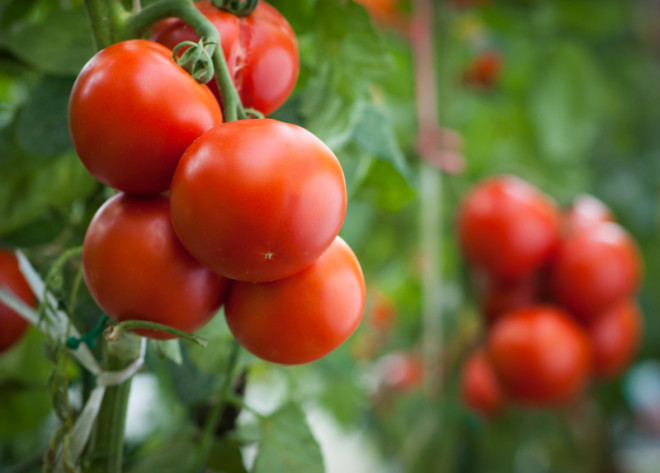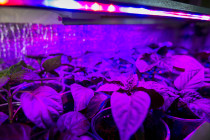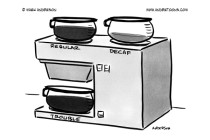The future of food production is aglow
Against the backdrop of a darkening blue sky, shades of magenta, bright purple, and brilliant gold punctuate the twilight like an electric sunset. As night approaches, the energy-producing potential of the sun’s rays takes pause until morning — unless, of course, you’re inside Stockbridge Technology Centre’s LED-lit greenhouse. Not only does the glass-walled facility create an incredible glow on the North Yorkshire horizon, the exciting research conducted inside its walls is casting a bright light on the future of plant growth and food production.
LED growing lamps: The right light at the right time means improved efficiency
As population growth and climate change threaten future food shortages, research is focused on new farming methods to produce food easily while reducing overall energy use. Dr. Martin McPherson, Science Director at Stockbridge Technology Centre (STC) in Selby, England joined forces with technology company Philips to create a 1,000 square metre “city farm” in a warehouse at the STC. Using a variety of blue, red, and ‘far-red’ light, these researchers are studying how to use LEDs to efficiently drive photosynthesis. McPherson explains: “Plants don’t need the full spectrum of light they get from the sun, so by using coloured lighting you can cut out the component parts you need and use them more efficiently.”
It’s not that LEDs are necessarily better for growing than traditional high-pressure sodium (HPS) lamps; the excitement over LED greenhouses stems (plant pun intended) from their ability to deliver the specific wavelengths of light that are most useful to plants, thereby increasing efficiency and reducing wasteful energy consumption. Researchers at STC are focused on determining which spectrum of light works best, when it is needed, and in what situations.
Advantages of LED plant lighting
McPherson says lighting manufacturers report growers are seeing energy savings in the range of 30-60% compared to plant lighting using traditional HPS lamps. Energy savings are expected to increase as the technology improves over the coming years.
Another major plus is LED plant lights produce much less heat than their HPS counterparts and, as a result, plants can be stacked in multilayer racks, which not only increases production, but creates opportunities for growing environments in atypical, smaller spaces such as urban warehouses.
The ability to construct indoor, urban greenhouses means a year-round growing season, as well as a reduction in time and costs associated with food travelling from ‘farm’ to table. Says McPherson: “There is a huge amount of interest from growers because this technology is potentially a game changer. It occurred to me… that this could be the key to kickstarting urban farming in the UK.” With the push for more locally sourced produce gaining momentum everywhere these days, the potential for energy-efficient, urban greenhouses is massive.
What does the future of LED greenhouses look like?
Currently, the team at STC is conducting growth trials that compare produce grown under LED and HPS lamps. This past December, they marketed the first Yorkshire-grown plum tomatoes of the year, which were “… very well received due to their exceptional, just-picked taste.”
STC researchers have also configured an optimal LED spectrum to produce year-round British strawberries. In fact, Wallings Nursery in Essex, one of the biggest suppliers of strawberries in the UK, will be using the technology to “ripen up to 30 tonnes of fruit that it would normally have thrown away” at the end of the typical growing season. This extra ‘crop’ is estimated to be worth £100, 000.
And lastly, Philips is using the feedback they receive from plant research customers to fine-tune their line of GreenPower LED growing lamps. They are working on improving energy savings while offering an array of options with “the best combinations of spectrum, intensity, moment of lighting, uniformity, and positioning to steer specific plant characteristics such as compactness, colour intensity, and branch development.” McPherson believes as the technology improves, LED growing will be able to change the colour, taste, and even nutrition levels of some fruits and vegetables.
Whether or not you have misgivings about food being produced under artificial light, the team at Stockbridge Technology Centre certainly makes a compelling case for an incredible application of LED technology. For them, the proof is in the taste of their tomatoes and about £100, 000 worth of strawberries.
About The Author

-
Serial Entrepreneur, Technologist and Inventor.
My objective is to develop useful products that have a net positive effect in the lives of those that use them and the environment that we live in.
CEO of Mission LED Lighting Company Ltd.
- 2017.05.24LED factsWhy Are Cars Switching to LEDs if They’re Too Bright?
- 2017.05.09Be green & saveHow to Easily Replace T8 Fluorescent Tubes With LED
- 2017.03.07Build a better future7 Things About Explosion Proof LED Lighting You Should Know
- 2017.02.28Be green & saveWhy We Love LED Grow Lights (And You Should, Too!)





1 Comment